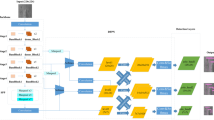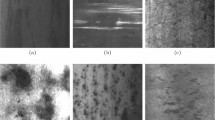Abstract
Semantic image segmentation is extensively used for automatic concrete crack detection. In previous studies on semantic image segmentation, concrete images were usually labeled as crack and noncrack zones, and recognition models were then trained using artificial neural networks. However, there is not enough edge information in concrete images for the trained model to identify effectively fine concrete cracks (widths < 0.1 mm). Furthermore, complex backgrounds in concrete images can cause false detections. To improve efficiency and reduce false detections, this study develops a three-stage automatic crack-width identification method for fine concrete cracks. First, a full crack skeleton information identification based on image segmentation is proposed. The performance of the mainstream image segmentation architectures, PSP-Net, Seg-Net, U-Net, and Res-Unet, are compared and analyzed, demonstrating that the Res-Unet-based crack skeleton segmentation is the most accurate at fine-crack detection and able to solve the information loss problem that occurs when learning the imbalanced data of fine concrete cracks. Second, a fractal dimension (FD)-based false detection removal process is applied to discriminate true cracks and false detections. The results show that false detections (line-like curves, shadows, and surface stains) can be removed, increasing the matching rate from 0.6476 to 0.8351. Finally, the FD features of the crack skeleton with maximum widths < 0.1 mm, crack widths in the range of 0.1–0.2 mm, and crack widths > 0.2 mm are calculated. Findings illustrate that the values of the FD feature for the three crack-width ranges are suitable for quantitative characterization of identified crack widths.







Similar content being viewed by others
References
ACI (2002) Control of cracking in concrete structures (Reapproved 2008). In: ACI PRC-224-01.ACI, Farmington Hills
Adhikari RS, Moselhi O, Bagchi A (2014) Image-based retrieval of concrete crack properties for bridge inspection. Autom Constr 39:180–194. https://doi.org/10.1016/j.autcon.2013.06.011
Nguyen HN, Kam TY, Cheng PY (2013) An automatic approach for accurate edge detection of concrete crack utilizing 2D geometric features of crack. J Signal Process Syst 77(3):221–240. https://doi.org/10.1007/s11265-013-0813-8
Yamaguchi T, Nakamura S, Saegusa R, Hashimoto S (2008) Image-based crack detection for real concrete surfaces. Transact Electr Electr Eng 3(1):128–135
Sankarasrinivasan S, Balasubramanian E, Karthik K, Chandrasekar U, Gupta R (2015) Health monitoring of civil structures with integrated UAV and image processing system. Procedia Comp Sci 54:508–515
Yang X, Li H, Yu Y, Luo X, Huang T, Yang X (2018) Automatic pixel-level crack detection and measurement using fully convolutional network. Comput-Aided Civ Infrast Eng 33(12):1090–1109. https://doi.org/10.1111/mice.12412
Huang HW, Li QT, Zhang DM (2018) Deep learning based image recognition for crack and leakage defects of metro shield tunnel. Tunn Undergr Space Technol 77:166–176. https://doi.org/10.1016/j.tust.2018.04.002
Lau SLH, Chong EKP, Yang X, Wang X (2020) Automated pavement crack segmentation using u-net-based convolutional neural network. IEEE Access 8:114892–114899. https://doi.org/10.1109/access.2020.3003638
Ren Y, Huang J, Hong Z, Lu W, Yin J, Zou L, Shen X (2020) Image-based concrete crack detection in tunnels using deep fully convolutional networks. Constr Build Mater 234:117367. https://doi.org/10.1016/j.conbuildmat.2019.117367
Chen T, Cai Z, Zhao X, Chen C, Liang X, Zou T, Wang P (2020) Pavement crack detection and recognition using the architecture of SegNet. J Ind Inf Integr 18:100144. https://doi.org/10.1016/j.jii.2020.100144
Hoang ND (2018) Classification of asphalt pavement cracks using Laplacian pyramid-based image processing and a hybrid computational approach. Comput Intell Neurosci 2018:1312787. https://doi.org/10.1155/2018/1312787
Aoshima K, Yamamoto T, Nakano S, Nakamura H (2020) Detection of deterioration area on concrete surface using segmentation method by deep learning. AI Data Sci 1(J1):481–490
Cha YJ, Choi W, Büyüköztürk O (2017) Deep learning-based crack damage detection using convolutional neural networks. Comput-Aided Civ Infrastructure Eng 32(5):361–378
Wang X, Wang Y, Yu L, Li Q (2023) Automated pavement crack detection based on multiscale fully convolutional network. J Eng 2023(10):e12317
He K, Zhang X, Ren S, Sun J (2016) Deep residual learning for image recognition. IEEE conference on Computer Vision and Pattern Recognition (CVPR), pp 770–778
Hosseini SA, Khah NKF, Kianoush P, Afzal P, Ebrahimabadi A, Shirinabadi R (2023) Integration of fractal modeling and correspondence analysis reconnaissance for geochemically high-potential promising areas. NE Iran Results Geochem 11(100026). https://doi.org/10.1016/j.ringeo.2023.100026
Sudre CH, Li W, Vercauteren T, Ourselin S, Cardoso MJ (2017) Generalised dice overlap as a deep learning loss function for highly unbalanced segmentations. In: Deep learning in medical image analysis and multimodal learning for clinical decision support. Springer, Cham, pp 240–248
Acknowledgements
This research was funded by the National Key Research and Development Program of China (Grant number: 2019YFC1511103), and the National Natural Science Foundation of China (Grant No. 52178115).
Author information
Authors and Affiliations
Corresponding author
Ethics declarations
Conflict of interest
The authors declare that they have no conflict of interest.
Additional information
Publisher's Note
Springer Nature remains neutral with regard to jurisdictional claims in published maps and institutional affiliations.
Rights and permissions
Springer Nature or its licensor (e.g. a society or other partner) holds exclusive rights to this article under a publishing agreement with the author(s) or other rightsholder(s); author self-archiving of the accepted manuscript version of this article is solely governed by the terms of such publishing agreement and applicable law.
About this article
Cite this article
Huang, H., Wu, Z. & Shen, H. A three-stage detection algorithm for automatic crack-width identification of fine concrete cracks. J Civil Struct Health Monit (2024). https://doi.org/10.1007/s13349-024-00797-7
Received:
Accepted:
Published:
DOI: https://doi.org/10.1007/s13349-024-00797-7




